A mudbrick home in Golden Bay inspired by Native American and Mediterranean styles
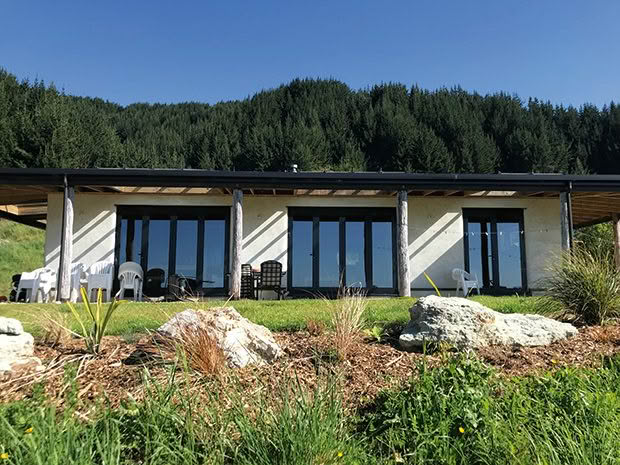
Inspired by Pueblo adobe architecture, Mike Rimu built his house out of locally-sourced, light adobe blocks. Adobe houses are valued for their thermal performance and low environmental footprint compared with houses constructed with other materials.
He led an intrepid life sailing around the globe on superyachts and cooking in the galleys of the wealthy. Now this Kiwi chef is living his dream to build an adobe earth house and develop a permaculture block.
Words: Nina Hindmarsh
WHO: Mike Rimu
WHERE: Golden Bay
WHAT: 2ha (4.9 acres), adobe earth house, locally-sourced materials; permaculture property.
It was a historic Native American village in Santa Fe, New Mexico, that first sparked the dream.
During his travels around the United States, chef Mike Rimu encountered the low-slung earth buildings in the Southwest desert, built from traditional adobe bricks – a mixture of sun-dried earth and straw – and knew he’d build one for himself some day.
Built by the Pueblo peoples, some of the buildings date as far back as the eighteenth century and are still standing today. The longevity of these still-inhabited homes struck Mike as extraordinary.
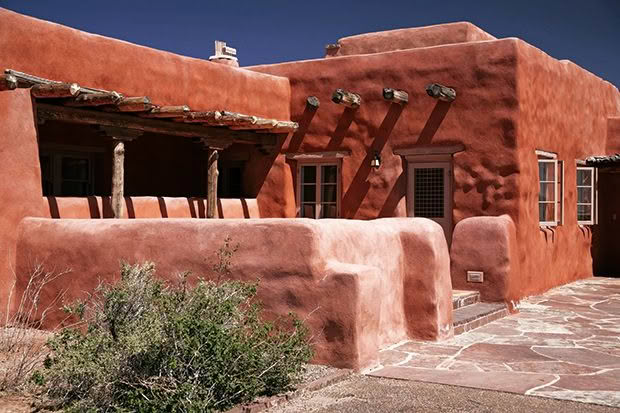
A traditional adobe house in the southwest United States.
He purchased a stack of second-hand books, all on New Mexico’s distinctive regional architecture, and pored over the images. The books featured an eclectic mix of Native American adobe buildings and homes, melded with the Spanish, Italian, and Mission Revival influences, giving rise to the unique Pueblo style.
“I just loved the Southwest feel,” Mike says. “The natural colours and materials with terracotta tiles, and the different blues and greens of the window frames and doors.”
Many years after first being inspired by the Puebloans, Mike’s two-bedroom light adobe home in Golden Bay is complete. Developing the foundations of a permaculture block has been keeping him busy, marking a new lifestyle era for the former travelling chef.
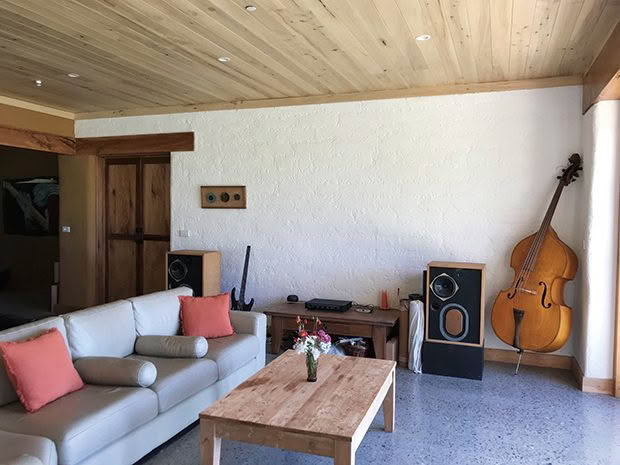
The white colour of Mike’s house is influenced by traditional Mediterranean architecture. The lounge has plenty of space to jam.
Born in Christchurch, at the age of 18, Mike shifted to the area northwest of Nelson, where he fell in love with the natural landscape and the region’s vibrant community.
It was in the 1990s when Mike found work cooking in kitchens, and in his spare time would play bass guitar in a band known as The State of It, forging friendships that would last decades.
His dream was always to one day settle down in Golden Bay. So when he was offered a pile of windfall tōtara from a local farm, he didn’t hesitate to mill the logs himself into slabs and then put them into storage.
“I just knew I was gonna build a house with all this. I just needed to travel, make some money, and have some adventures first.”
A DETOUR TO THE DREAM
In the early 2000s, Mike made his way to Florida, unaware that this was where he would base himself for nearly 20 years, sailing the globe and dishing up five-star meals to Wall Street tycoons on $200- million-dollar yachts. One superyacht voyage led to another, and eventually he got married and bought a house in Florida.
His work took him all around America, the Mediterranean, and Eastern Europe. “Culinary-wise, it was just incredible,” Mike says. “The food markets were just amazing, and there was no [limit to the] budget. All the different cheeses and cured meats; all those different coloured vegetables. I just learned so much about produce and how to cook a bunch of different things.”
During his travels through the Greek, Italian and Spanish islands of the Mediterranean, Mike was struck by the distinctive earth-building styles – curved archways and white stucco exteriors – all of which added to the inspiration of his future home.
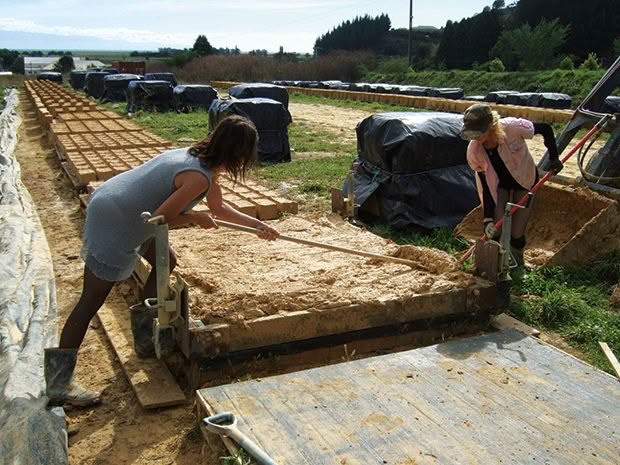
Mud bricks being manufactured at Nelson’s Solid Earth. These are made of earth with a high content of clay and straw. When manufactured by hand, the earth mix is cast in open moulds onto the ground and then left to dry out. Adobe bricks are only sun-dried, not kiln-fired.
“The Southwest [of the US] has terracotta, while the Mediterranean is white, which really adds this brightness. When I came down to a final design for the house, I just had to go with both styles. It’s a homage to both, I guess.”
In 2015, Mike divorced and finally returned to Golden Bay. He purchased two hectares of bare, rugged land in Ligar Bay, then ventured back to Florida with a five-year plan to make money and return for the build.
That he did. Mike got in touch with Richard Walker, a consulting structural engineer who helped write the New Zealand Earth Building Standards. Because of NZ’s wet climate, he told
Mike not to bother with the straw bale typically used in adobe construction.
He recommended light adobe, over rammed earth, because of its better insulation properties.
He put Mike in touch with Solid Earth, a company near Nelson, run by Verena Maeder and Scott Davidson, which specialises in manufacturing adobe bricks from locally-sourced materials. Mike handed over his design to a local architect who was familiar with adobe, and in the summer of 2019, Solid Earth started making the first lot of the 3,500 bricks needed to complete the home.
By early 2021, Mike was living in an old bus at the bottom of the property, after spending “a fair amount of money and time on diggers developing the land”. It was time to start building.
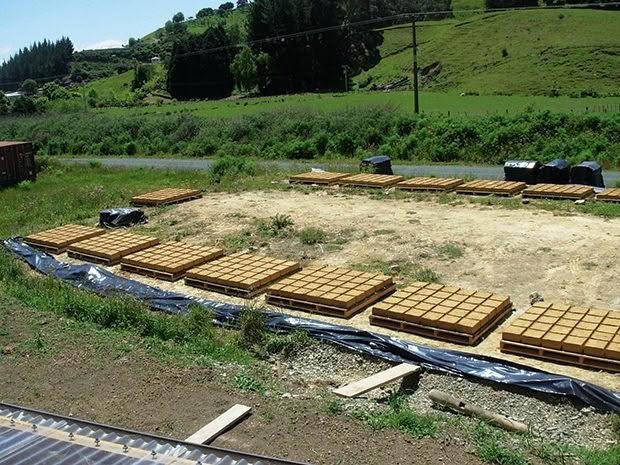
THE BAND REUNITES
To construct the house, Mike’s 90s Golden Bay band, The State of It, all reunited to help do the brickwork. Handily, one of them works as a professional builder. Verena also made the trip to Golden Bay to do a one-day workshop with Mike and his bandmates, to show them how to construct with the bricks.
Mike says the process of building a home – much of it with his own hands – was a challenge and a dream at the same time. “I had a good plumber and electrician, but it was basically my band that helped me build the house.”
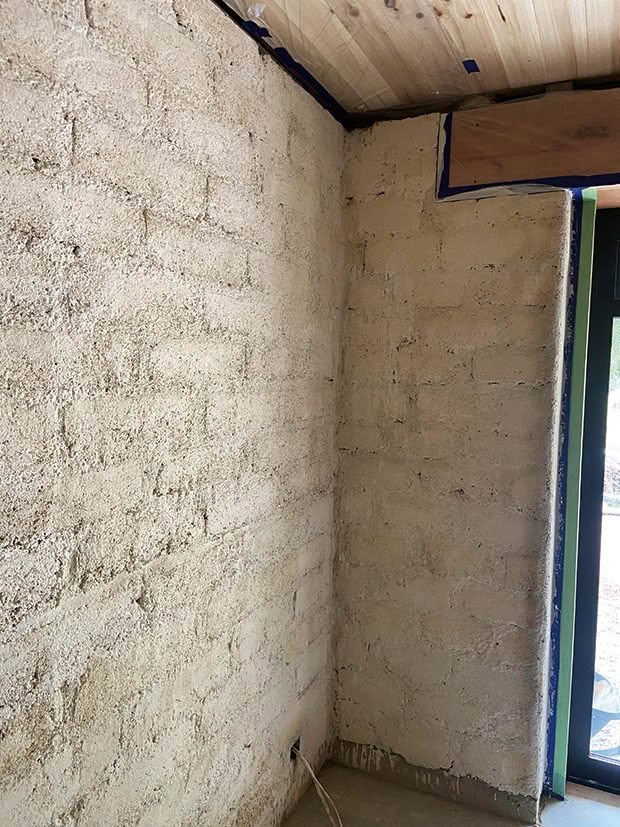
The light adobe bricks were put in at 17 high, with each course (set of bricks) taking a full day to complete for both external and internal walls. In total, putting in the 3,500 bricks took 17 days, but was stretched out over a six-week period due to wet weather. The rain was one of the only major challenges in the whole build, Mike says. “It would basically rain for a few days, and we’d have to cover everything up in plastic, then I’d have to sweep all the water out and uncover everything, and start again.”
Once the bricks were in place, they put the roof on, and the band dispersed. Mike finished all the interior work with his friend, the builder. “We had this whole room set up like a workshop. I got all these slabs [of tōtara] that I’d milled up from the 90s. We just started machining everything up.”
A local joiner taught Mike how to make mortar and tenons, and Mike hand-crafted all the windows, doors, the dining table, bench seats and the countertop.
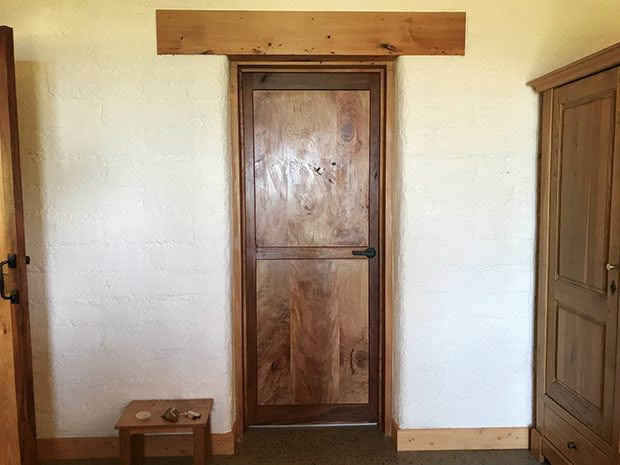
Instead of polystyrene, Mike opted for a new underfloor insulation technology, QPODs. The recycled plastic pods, manufactured in Hawke’s Bay, trap air under the concrete to build up thermal mass. He thinks it might be the first house in Golden Bay to have them installed. The floor was then finished with polished concrete.
To achieve both the New Mexico and Mediterranean architectural styles, Mike finished the north-facing, sunny interior walls with rehydrated lime wash, but experimented with leaving a thin enough coat so the texture and shape of the bricks showed through.
For the south-facing back walls, which is the shadier side of the house, Mike sourced a trailer load of terracotta-coloured clay from a nearby property. He sieved it, then mixed it with river sand, before applying it over the bricks to achieve a traditional Pueblo look. In his bedroom, he mixed a natural dye with the clay, for a different tone.
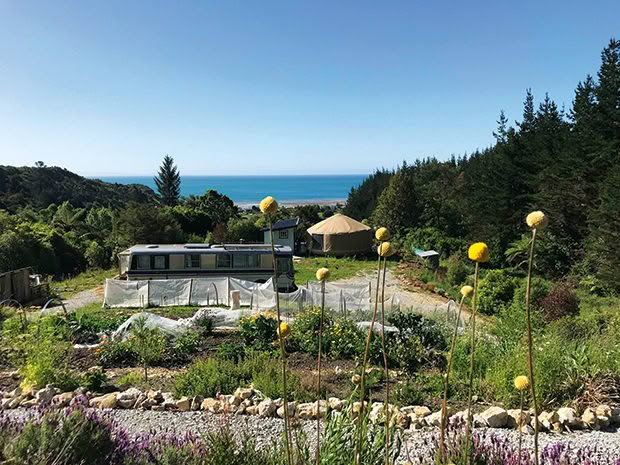
Although the house is complete, the project is far from over. He’s still dreaming up plans to construct a Mediterranean-style outdoor patio with a kitchen, bbq, and pizza oven, to host dinner parties for friends, and lavish them with exceptional home cooking. His partner, Kylie Sinkovich, a contemporary jeweller, keeps him company in the cosy home these days, and he’s transformed the second lounge into a “jam room” for the newly revived band.
Apart from the wet weather, Mike says his biggest struggle was just settling down. “Coming from a million miles an hour, different cities and coasts, to backcountry Golden Bay; I was lucky, all my friends were still together from the 90s. We started BBQing and playing live music together again, so it was like slotting back in.”
DEVELOPING THE LAND
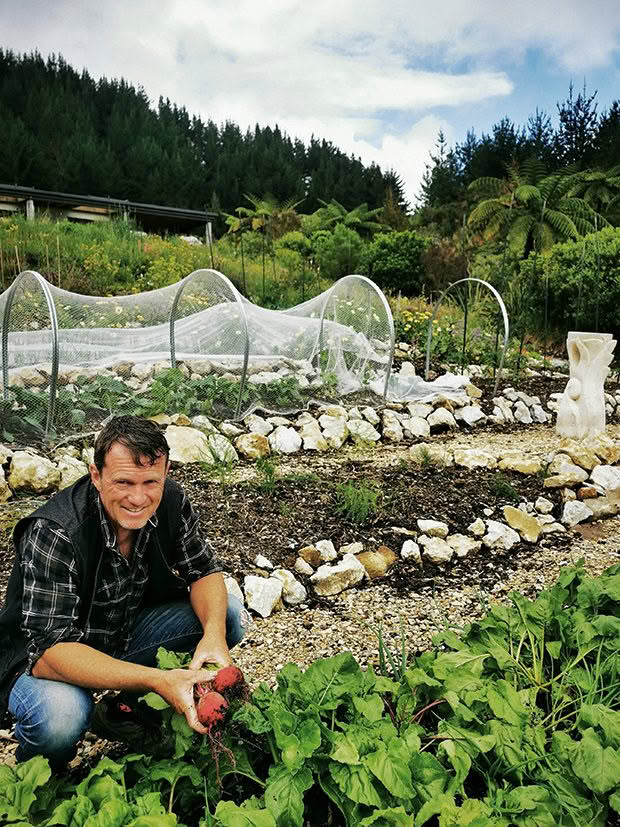
Mike in his garden. He hopes to use his property to host guests and take them on culinary journeys in which they’ll eat high-quality, locally-grown produce and discover unique but delicious food pairings.
When he wasn’t building, Mike spent countless hours developing the gardens and planting them out with natives, flowers, herbs, fruit trees, and berries, many of which are heirloom varieties he purchased from Northland’s Forgotten Fruits. He’s in the process of building up the soil and turning the property into a permaculture paradise, where he can eventually make money off the land by combining his love for fresh produce with his culinary skills.
In 2021, as an experiment, Mike planted a cut flower garden as a potential business prospect, growing sweet peas, sunflowers, dahlias, ranunculus, and anemones. However, “chef’s garden” is getting most of his attention nowadays, as is the yurt he’s renovating for an Airbnb. He’s got ideas to cook for his guests, or at least to grow enough fruits, herbs, and vegetables to provide for them, as part of the “Golden Bay experience”.
Inspired by his superyacht experience, he’s cooking up plans to run cuisine workshops and supper clubs out of his kitchen and gardens.
“Basically, all I want is to be able to cook out of the garden and use my skills to have this as a little private venue for people.
I basically love cooking but don’t want to do it at a restaurant. I love the idea of using all seasonal and local, matching local meats with local cheeses and veggies from the different growers around here. One of my favourite cookbooks is called The Flavour Bible. It’s basically flavour matching, so the idea is whatever [produce or product] you’ve got, you have an understanding of what other ingredients match well with these.”
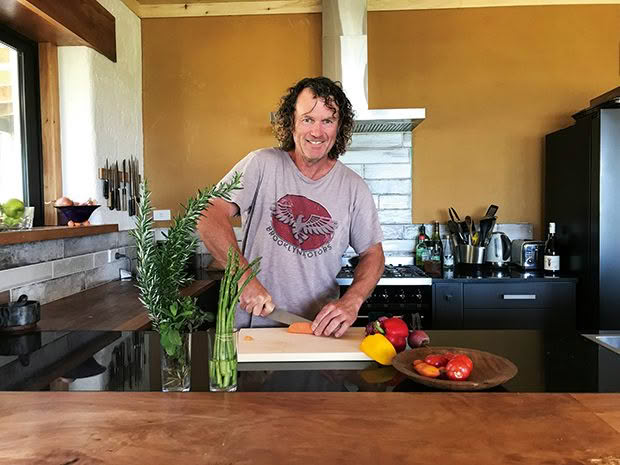
Mike says it’s about experimenting and tasting the subtle differences, taking people on a culinary journey with different vegetables and herbs; awakening their senses and making them think about what they can do with their food, instead of just learning recipes.
“At the moment I’ve got cinnamon basil, holy basil, lemon basil, dark opal basil, and Thai basil. Imagine matching that with different varieties of tomatoes, and tasting the different sensations.
“Anyone can look up a recipe online, but if you really don’t know about ingredients and all those basics, you don’t know how to be adventurous or make substitutions. The veggies at the supermarket make me pretty sad. I want people to demand better, high-quality fresh produce.”
Mike says Golden Bay has got almost everything it needs for the community to become self-sufficient. He hopes that the region can one day become it’s own brand, with an organised collective of local growers who are able to get their products in restaurants and supermarkets.
SETTLED IN
Now living in his adobe house, Mike has no regrets about his decision to settle down. His home is a consistent 18°C year-round, and with grid-tied solar power and a wetback, he’s already making savings.
“Build-wise, it wouldn’t have cost me much more than an average spec house. But with its energy usage, longevity, and the fact that it’s low maintenance, adobe was the perfect product for what I wanted. The cladding on most modern houses only lasts 50 years these days. Obviously, my roof will have to be replaced one day, but with the right maintenance, the house should last a few hundred years.”
WHAT IS ADOBE?
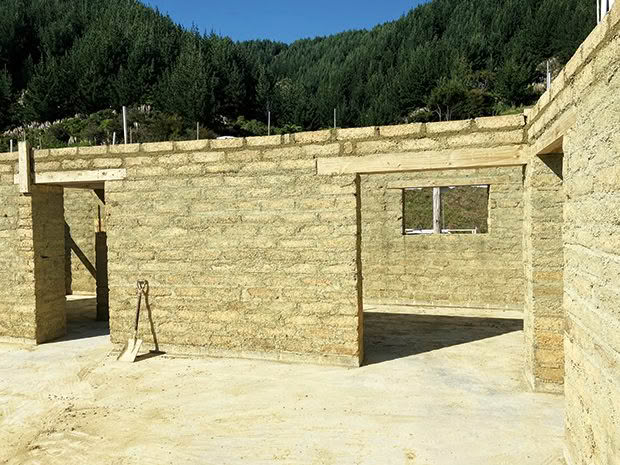
Adobe translates to “mudbrick” in Spanish. The building process is one of the oldest and most widespread forms of construction, with archeological records dating as far back as 8300 BC. The method uses compressed earth, straw, clay, or other natural materials to build low-energy, biodegradable structures. It works by building up and releasing thermal mass slowly, providing efficient heating and cooling. It was a popular method in the Middle East and the Americas, often used in arid climates where timber was scarce.
In the west, adobe construction has seen a revival in recent times, due to its low environmental impact, efficient thermal performance, and fireproof properties. In Colorado, residents whose homes were damaged by the 2021 Marshall Fire have been rebuilding with adobe bricks. Research from the University of California, Davis, found the high heat of wildfires can actually fortify the bricks, making the houses more robust.
Because the method uses natural materials, research has shown its environmental footprint is far smaller than some modern building methods, which often produce hazardous waste and see a high net energy consumption. Locally-sourced materials also contribute to lower transportation costs and energy consumption.
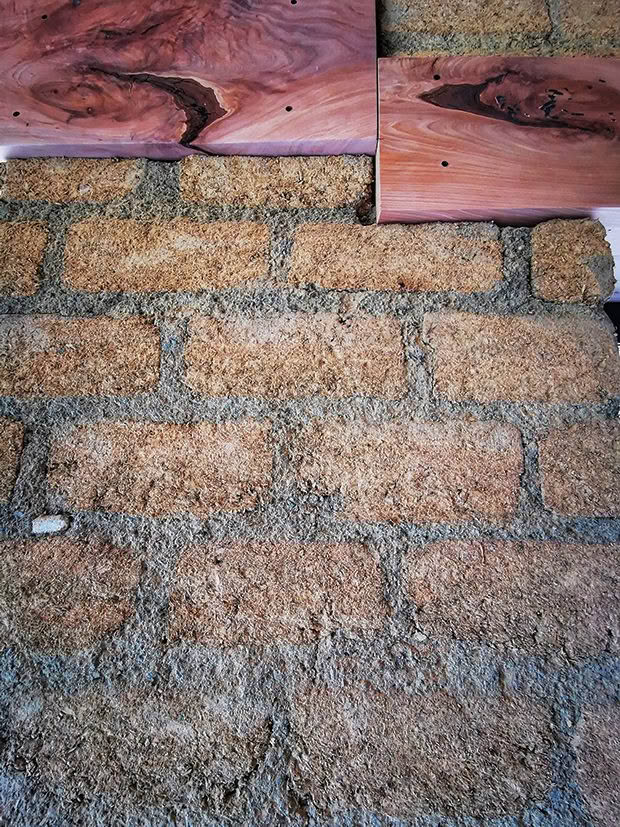
Solid Earth manufactures its bricks out of a mixture of Moutere clay, untreated wood waste, and recycled paper pulp. They are then cast by hand in wooden moulds, and left to dry in the sun.
Verena Maeder said their bricks had gone through a rigorous research and development process in the last decade to increase insulation levels, in response to the energy efficiency regulations.
While traditional adobe bricks are heavy, these have been designed with wood fibre and cellulose, to be low-density and lightweight.
They were developed with the engineering faculty at Auckland University, going through full-scale earthquake testing and thermal modelling.
“People still think adobe is an ‘alternative’ building method,” Verena says. “But it’s been in the New Zealand Building Standards since 1998. In 2020 these got revised, with low-density adobe taken into the standard as well.” She says NZ should be proud of its earth-building standards, which are some of the most progressive in the world and the only standards to recognise low-density adobe.
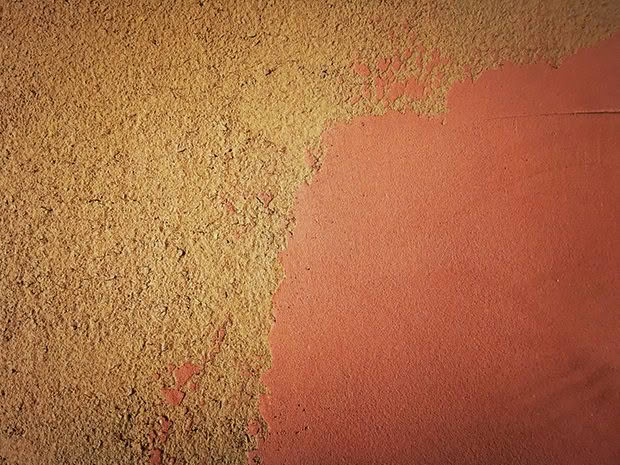
Mike’s house in various stages of construction. The layers of pre-made bricks are stablished with a mortar of mud or cement as they’re laid out. Before drying out, the finished walls are smoothed down. A clay render is often applied as a surface coating.
“Adobe is a humble product, but it ticks so many boxes,” she says.
“Anywhere you find clay there is some kind of earth-building tradition, it just looks different from region to region.”
Verena and Scott have been producing bricks for around 20 years, for an estimated 200 projects, and around 20 historic building restorations. They also teach adobe workshops around New Zealand, and run a three-month online course for people, nationally and internationally, to learn more about this building method.
Verena says one of the biggest advantages of the adobe system is that it allows the individual units or bricks to shrink before they are placed in the wall. The risk of extensive shrinkage and cracking, which would otherwise occur in soils of high clay content in a large monolithic wall, is prevented.
Adobe materials are non-toxic, durable yet biodegradable, and relatively simple to use. With adequate supervision and onsite training, the technique allows owner-builders to build without the need for costly tools or equipment.
Mike’s Tofu Poke Bowls
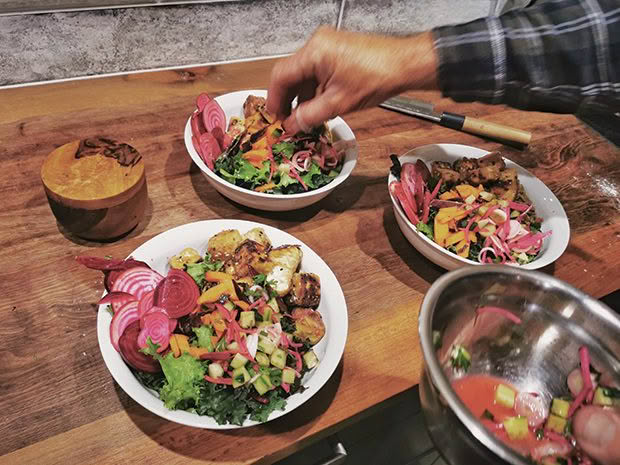
Serves: 2
Prep time: 2 hours
Cook time: 30 mins
INGREDIENTS
150g edamame noodles
1 tsp sesame oil
2 handfuls mixed salad greens or foraged weeds (rocket, mizuna, lettuce, puha etc).
1 ripe avocado
seeds, to sprinkle
a dressing, of your choice
Marinated crispy tofu:
300g firm tofu
40ml tamari
20ml sweet chilli sauce
1cm knob of ginger, grated
1 clove of garlic, finely diced
20ml toasted sesame oil
¾ cup brown rice flour
1 tbsp white sesame seeds
1 tbsp black sesame seeds
2 tbsp grape seed oil
Pickled beets and carrots:
1 large beet or 2 medium beets, thinly sliced
2 carrots, julienned
¼ red onion, shaved, or thinly sliced
a handful of mint, thyme, or dill
40ml rice wine vinegar
20ml water
salt and pepper to taste
Pickled cucumber and spring onions:
1/3 of a telegraph cucumber, seeds removed, then diced
3 spring onions, sliced
1 watermelon radish, or radish (optional)
a handful of chives, dill, or parsley
1 lemon, squeezed
20 ml mirin
salt and pepper
METHOD
Cook the edamame noodles according to packet instructions, then add sesame oil.
To make the marinated, crispy tofu, dice tofu into 2cm chunks, and place in a bowl. In a bowl, mix the tamari, sweet chilli sauce, ginger, garlic, and sesame oil, then pour over the tofu. Marinate for at least 30 minutes, or up to 2 hours.
Pickle the vegetables by mixing the ingredients for pickled beets and carrots in one bowl, and the ingredients for pickled cucumber and spring onions in another. Leave for 30 minutes, or up to 2 hours.
Once the tofu has marinated, mix the rice flour with sesame seeds in a separate bowl. Roll the marinated tofu in the dry mix, coating the pieces. Heat a pan on medium-high with grapeseed oil, and cook until the tofu is lightly browned. Set aside.
To assemble, place the cooked noodles in the bottom of a large bowl. Add the mixed greens to one side, and the pickled beets and carrots to the other. Add the pickled cucumber and spring onions, and crispy tofu.
Dice the avocado and place it on top. Sprinkle seeds, or nuts and sprouts. Finish with a drizzle of dressing.
Love this story? Subscribe now!
 This article first appeared in NZ Lifestyle Block Magazine.
This article first appeared in NZ Lifestyle Block Magazine.
